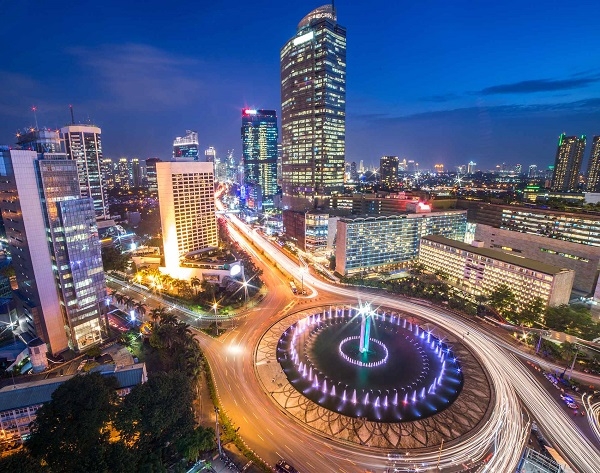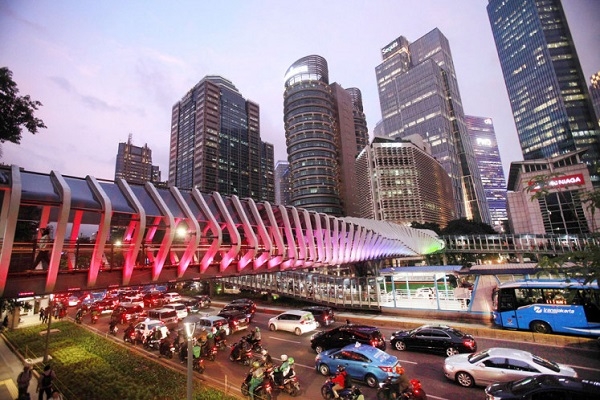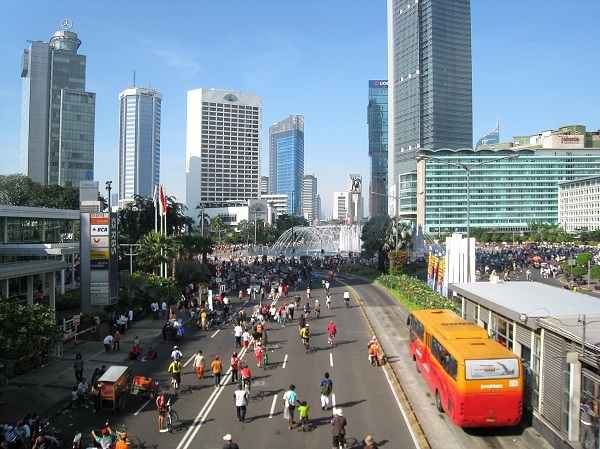Times of Ind(one)sia - III
Total Views |
Having gone through the historical connectedness of India and Indonesia and certain social aspects, I’m sure, you’d be keen to know more about my ‘tourist’ experiences there. The schedule at Bandung was quite busy, as it depended on the tournament schedule as well the travel time to and from the venue. However, presenting to you what I came across, as follows:
BANDUNG
Although it’s called ‘Paris of the East’ if you search the web, it’s a much hyped claim sans reality. However, a few things there are indeed pleasing to the eyes of a tourist. My hotel was in ‘Cihampelas’ area, which had a long ‘Denim Street’ on one side and a string of possibly the grandest houses (in the city) lining a quaint street, going parallel on the outer side. I suspected some of them to be of high government officials, going by appearance and a certain type of security arrangements, though none of them bore any names, but only numbers. That setting nevertheless provided for my refreshing morning walks.

Visited the ‘Asia Africa (they spell it Afrika as in Dutch) Street, which was named so, post the historical conference of the nations from the two continents held there in 1955. Indonesia Govt. established a museum in 1980, in memory of the said conference, which was also a part of the ‘Non-aligned Nations’ movement, led inter alia by India’s then PM Nehru. India was one of the five sponsoring nations of the said conference. Certain ‘Dasa Sila’ (Ten Principles) had emerged out of it, pertaining to international relations, binding the attending nations, one of whom was also Pakistan. If you looked at those ‘Dasa Sila’ you’d find Pakistan violating eight of them historically. The Conference’s golden jubilee was celebrated in year 2005, which gave rise to a new set called ‘Nawa Sila’ (Nine Principles), previous ‘Dasa Sila’ being one number among them. And again at a glance, you’d find Pakistan guilty of violating eight. It thus proves the futility of such nice sounding gatherings, lacking the teeth of deterrents for the violators.
Had a funny moment at the toilets of that museum. There were no pictures on the doors but only ‘Bahasa’ indications. The men’s section was ‘Pria’ while women’s was ‘Wanita’. Now wanita in Sanskrit is woman, which I knew but couldn’t digest ‘pria’ to be a man. So ignoring ‘wanita’ & taking pria to be closer to a woman, I advanced towards ‘wanita’. Luckily, a ‘wanita’ came out of that door that moment and thus saved me from any potential embarrassment.
Jakarta (Jayakarta, etymologically)
The memorable part was my visit to ‘Taman Mini Indonesia Indah’ (TMII), where I spent around five hours, touring on foot & on my local guide’s bike, the 78 hectares of the space, showcasing the cultural highlights of 34 provinces of Indonesia. The country, like ours, is full of variety in terms of tribal ethnicity, their attire, hundreds of their languages/dialects. Most of such things were on display there.
In one of the province’s (Sulawesi) earmarked area, while I was observing the replica of its traditional community hall (and court of trial, when needed), the caretaker approached me guessing right that I was an Indian, for a conversation. He spoke the best English I had so far come across, much better than even the supposedly trained hotel staff, and made my day by providing some precious information. He pointed at one of the engravings on the structure I was observing and told me that it was phallus, an important symbol (of fertility) for the then largely tribal populated province, following ‘animist’ traditions. I didn’t disturb his flow by telling him about ‘Shiva Linga’, which nevertheless made an appearance in my mind. Would have the then weakening Indian (Hindu) connection been the cause of the ‘animists’ being dethroned from their position of prominence and driven to the mountains and the forests, where they are surviving today, in Silawesi as well as other provinces of Indonesia? A topic for research isn’t it!

Met a Balinese Hindu woman caretaker in the Bali section, who too provided a few great insights. The name-plates there were in Balinese (in addition to English), in some unrecognisable (called ‘Aksara’, meaning alphabets in Sanskrit) script. The caretaker informed me that it had resemblance to Cambodian script. In the Javanese section, the script resembled that of the Thai language. My little Google research told me that all these scripts were derived from the ‘Brahmi’ script of ancient India. The great Indian connection again! She checked with me whether Indian Hindus had a tendency to be devotees of a particular deity only, like Krishna. When I said yes, she informed me that such wasn’t the case with the Balinese. All of them believed in the Dewaya (a cluster of deities) collectively. Could it have been the reason for them to stay united and retain Bali’s Hindu identity, when the rest of Indonesia turned Islamic? Research needed!
Interestingly, the ‘Hakka Museum’ in TMII, set up by the ethnic Chinese community of Indonesia engaged me for a good amount of time. It provided the background information with regard to the presence of the ethnic Chinese in the country, having migrated around 750 years from Fujian province of today’s China. It left no stone unturned in claiming the community’s rootedness in the Indonesian culture. Having given first the 750 years’ story on the 3rd floor (where it all began), they possibly got carried away and spoke of 2000 years’ presence in one province viz. Kalimantan, on the 1st floor, erring on self-contradiction. Although informative and done with due attention, it all looked a bit overdone, perhaps attempting to get over the trauma of native Indonesians erupting into riots against them at times. However, the museum also contained a kind of hall of fame, where they displayed the photo-frames of the eminent among them. It was interesting to notice names like, Komala Dewi, Suwarno Chandra, Indra Gunawan, Chandra Wijaya among them, ethnic Chinese Indonesians donning Indian names! On the international sports scene, it was All England title winner Rudy Hartono Kuriawan and Olympian athlete Susi Susanti, who were among them.
Trans-Jakarta
That’s the name of the efficient public bus service, covering all corners of the city through many (around 10) lines, like what the metro in Paris does. I boarded it 1st time at 10.30 am for the TMII trip and finally bid it good bye at 12.30 midnight (a few lines being operational 24/7), by spending mere INR 200/- for the whole of it. The staff at the boarding points spoke good English and genuinely cared for their foreign travelers like me, by passing on instructions to their colleagues on the bus, for my help. These AC buses have their dedicated line on the roads, which causes their quick movement despite heavy traffic. Hats off to Trans-Jakarta!
When I was just a few minutes away from my destination and waiting to alight in the midnight, a co-passenger, who looked like (a drunk) Indian, started conversing with me in Bahasa. He turned out to be a Yemeni but a fan of Mr. Big B. He tried proving it to me by singing “kabhi kabhi mere dil mein” & “gujarati ma bole tane prem karoon chhoon”. I appreciated him for that smilingly and then parted ways briskly.

CAFÉ BATAVIA
This fabulously decorated western café was placed at a corner of a European style public square, standing in the old town Batavia (Dutch name of Jakarta), the administrative block of Dutch Indonesia. Although the décor was western and the staff spoke good English, much of the menu was local and pricey. I however experienced the most touching moment there when I ordered a rice dish that, according to the printed menu, contained shrimps & chicken. After taking the order to the kitchen, the waiter returned to me and informed that although it wasn’t mentioned on the menu, the preparation did involve addition of some grated beef, for an enhanced taste. He explained, after seeing me visibly surprised at this, that he had guessed me to be an Indian and thought that beef wouldn’t be acceptable to me and so he came to check it out with me. I thanked him profusely for his sensitivity and the sense of concern he had for me and then advised him to avoid the beef.
I checked with the staff out of curiosity whether the meats in their kitchen were ‘halal’ and if their customers (who largely were local Muslims) cared to check about that. The answer was some of the meats were ‘halal’ on a given day, while some others were not and they informed their customers about that, if at all they cared to check. That insight heightened the intensity of the heartening moment I’ve narrated above. While leaving the square, I noticed that the street across had become very lively with booze, hukkah, music etc. crowded by youngsters, enjoying their open air, inexpensive parties. On a casual enquiry, I got to know that it’s like that every night there upto 4 a.m. That was a bit of the night life of Jakarta!
That’s all from my side! Hope it was enjoyable! I recommend Indonesia visit to you, to feel connected your Indian roots better!

